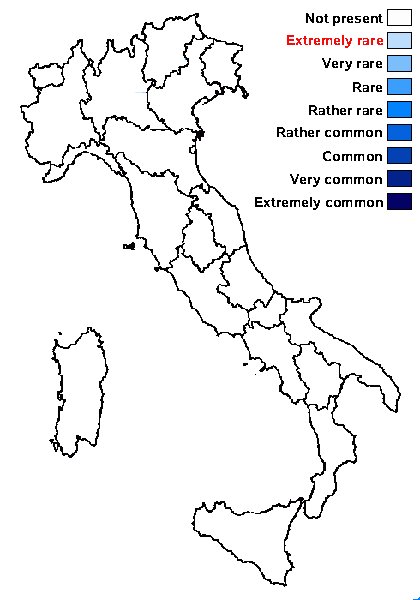Aspicilia fimbriata (H. Magn.) Oxner
in Kopaczevskaja & al., Opredelitel' Lishaĭnikov SSSR Vypusk (Leningrad) 1: 213, 1971, comb. inval.. Basionym: Lecanora fimbriata H. Magn. - K. svenska Vetensk-Akad. Handl., ny f. 17, 5: 171, .1939.
Synonyms:
Distribution:
Description: Thallus crustose-placodioid, episubstratic, 0.1-0.2 mm thick, grey-brown, forming 1-2.5 cm wide, often confluent, orbicular rosettes; marginal lobes 1-2 mm long, 0.15-0.2 mm wide, branched, discrete, without a distinct hypothallus between them; central parts of thallus of discrete, convex, 0.3-0.5 mm wide, wart-like areoles. Cortex 30-50 µm thick, overlain with an olive-brown, 6-8 µm thick epinecral layer; algal layer 50-70 µm thick; medulla white, poorly developed. Apothecia aspicilioid, round to irregular in outline, 0.2-0.4(-0.5) mm across, with a black. epruinose disc and a raised thalline margin. Exciple cellular, I+ pale blue; epithecium olivaceous brown; hymenium colourless, c. 85 µm high, I+ reddish brown; paraphyses simple or sparingly branched in upper part, c. 1.7 µm thick, non-moniliform, the apical cells up to 3.5 µm wide; hypothecium colourless, c. 35 µm high. Asci 8-spored, clavate, the thin outer coat K/I+ blue, the wall and apical dome K/I-. Ascospores 1-celled, hyaline, ellipsoid, 14-16 x c. 8.5 µm. Photobiont chlorococcoid. Spot tests: thallus K+ yellow turning red (needle-like crystals), C-, KC-, P+ yellow. Chemistry: norstictic acid.Note: based on a type from Siberia, this silicicolous species with very thin marginal lobes has been also reported from a few localities in the Eastern Alps (Austria); the conspecificity of populations from the Alps is uncertain. To be looked for in the Italian Alps.
Growth form: Crustose placodiomorph
Substrata: rocks
Photobiont: green algae other than Trentepohlia
Reproductive strategy: mainly sexual
Poorly known taxon in need of further study

Predictive model
Growth form: Crustose placodiomorph
Substrata: rocks
Photobiont: green algae other than Trentepohlia
Reproductive strategy: mainly sexual
Poorly known taxon in need of further study

Predictive model
 Index Fungorum
Index Fungorum
 GBIF
GBIF

